Hien Van Nguyen
Interpreting Radiologist's Intention from Eye Movements in Chest X-ray Diagnosis
Jul 16, 2025Abstract:Radiologists rely on eye movements to navigate and interpret medical images. A trained radiologist possesses knowledge about the potential diseases that may be present in the images and, when searching, follows a mental checklist to locate them using their gaze. This is a key observation, yet existing models fail to capture the underlying intent behind each fixation. In this paper, we introduce a deep learning-based approach, RadGazeIntent, designed to model this behavior: having an intention to find something and actively searching for it. Our transformer-based architecture processes both the temporal and spatial dimensions of gaze data, transforming fine-grained fixation features into coarse, meaningful representations of diagnostic intent to interpret radiologists' goals. To capture the nuances of radiologists' varied intention-driven behaviors, we process existing medical eye-tracking datasets to create three intention-labeled subsets: RadSeq (Systematic Sequential Search), RadExplore (Uncertainty-driven Exploration), and RadHybrid (Hybrid Pattern). Experimental results demonstrate RadGazeIntent's ability to predict which findings radiologists are examining at specific moments, outperforming baseline methods across all intention-labeled datasets.
Beyond the First Read: AI-Assisted Perceptual Error Detection in Chest Radiography Accounting for Interobserver Variability
Jun 16, 2025Abstract:Chest radiography is widely used in diagnostic imaging. However, perceptual errors -- especially overlooked but visible abnormalities -- remain common and clinically significant. Current workflows and AI systems provide limited support for detecting such errors after interpretation and often lack meaningful human--AI collaboration. We introduce RADAR (Radiologist--AI Diagnostic Assistance and Review), a post-interpretation companion system. RADAR ingests finalized radiologist annotations and CXR images, then performs regional-level analysis to detect and refer potentially missed abnormal regions. The system supports a "second-look" workflow and offers suggested regions of interest (ROIs) rather than fixed labels to accommodate inter-observer variation. We evaluated RADAR on a simulated perceptual-error dataset derived from de-identified CXR cases, using F1 score and Intersection over Union (IoU) as primary metrics. RADAR achieved a recall of 0.78, precision of 0.44, and an F1 score of 0.56 in detecting missed abnormalities in the simulated perceptual-error dataset. Although precision is moderate, this reduces over-reliance on AI by encouraging radiologist oversight in human--AI collaboration. The median IoU was 0.78, with more than 90% of referrals exceeding 0.5 IoU, indicating accurate regional localization. RADAR effectively complements radiologist judgment, providing valuable post-read support for perceptual-error detection in CXR interpretation. Its flexible ROI suggestions and non-intrusive integration position it as a promising tool in real-world radiology workflows. To facilitate reproducibility and further evaluation, we release a fully open-source web implementation alongside a simulated error dataset. All code, data, demonstration videos, and the application are publicly available at https://github.com/avutukuri01/RADAR.
Enhancing Radiological Diagnosis: A Collaborative Approach Integrating AI and Human Expertise for Visual Miss Correction
Jun 28, 2024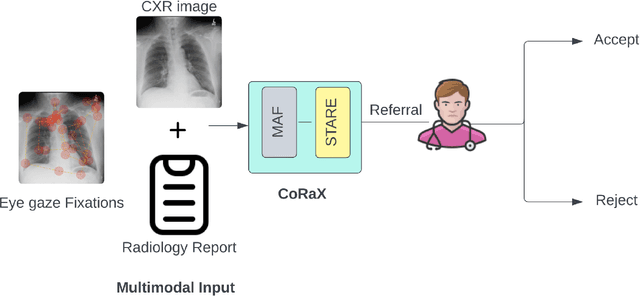

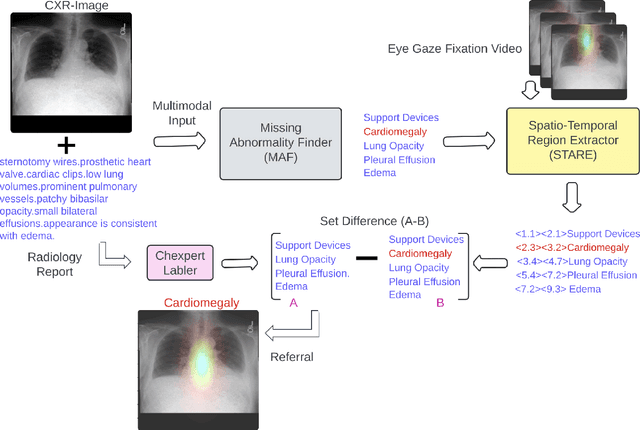

Abstract:Human-AI collaboration to identify and correct perceptual errors in chest radiographs has not been previously explored. This study aimed to develop a collaborative AI system, CoRaX, which integrates eye gaze data and radiology reports to enhance diagnostic accuracy in chest radiology by pinpointing perceptual errors and refining the decision-making process. Using public datasets REFLACX and EGD-CXR, the study retrospectively developed CoRaX, employing a large multimodal model to analyze image embeddings, eye gaze data, and radiology reports. The system's effectiveness was evaluated based on its referral-making process, the quality of referrals, and performance in collaborative diagnostic settings. CoRaX was tested on a simulated error dataset of 271 samples with 28% (93 of 332) missed abnormalities. The system corrected 21% (71 of 332) of these errors, leaving 7% (22 of 312) unresolved. The Referral-Usefulness score, indicating the accuracy of predicted regions for all true referrals, was 0.63 (95% CI 0.59, 0.68). The Total-Usefulness score, reflecting the diagnostic accuracy of CoRaX's interactions with radiologists, showed that 84% (237 of 280) of these interactions had a score above 0.40. In conclusion, CoRaX efficiently collaborates with radiologists to address perceptual errors across various abnormalities, with potential applications in the education and training of novice radiologists.
Multimodal Learning and Cognitive Processes in Radiology: MedGaze for Chest X-ray Scanpath Prediction
Jun 28, 2024



Abstract:Predicting human gaze behavior within computer vision is integral for developing interactive systems that can anticipate user attention, address fundamental questions in cognitive science, and hold implications for fields like human-computer interaction (HCI) and augmented/virtual reality (AR/VR) systems. Despite methodologies introduced for modeling human eye gaze behavior, applying these models to medical imaging for scanpath prediction remains unexplored. Our proposed system aims to predict eye gaze sequences from radiology reports and CXR images, potentially streamlining data collection and enhancing AI systems using larger datasets. However, predicting human scanpaths on medical images presents unique challenges due to the diverse nature of abnormal regions. Our model predicts fixation coordinates and durations critical for medical scanpath prediction, outperforming existing models in the computer vision community. Utilizing a two-stage training process and large publicly available datasets, our approach generates static heatmaps and eye gaze videos aligned with radiology reports, facilitating comprehensive analysis. We validate our approach by comparing its performance with state-of-the-art methods and assessing its generalizability among different radiologists, introducing novel strategies to model radiologists' search patterns during CXR image diagnosis. Based on the radiologist's evaluation, MedGaze can generate human-like gaze sequences with a high focus on relevant regions over the CXR images. It sometimes also outperforms humans in terms of redundancy and randomness in the scanpaths.
Decoding Radiologists' Intentions: A Novel System for Accurate Region Identification in Chest X-ray Image Analysis
Apr 29, 2024Abstract:In the realm of chest X-ray (CXR) image analysis, radiologists meticulously examine various regions, documenting their observations in reports. The prevalence of errors in CXR diagnoses, particularly among inexperienced radiologists and hospital residents, underscores the importance of understanding radiologists' intentions and the corresponding regions of interest. This understanding is crucial for correcting mistakes by guiding radiologists to the accurate regions of interest, especially in the diagnosis of chest radiograph abnormalities. In response to this imperative, we propose a novel system designed to identify the primary intentions articulated by radiologists in their reports and the corresponding regions of interest in CXR images. This system seeks to elucidate the visual context underlying radiologists' textual findings, with the potential to rectify errors made by less experienced practitioners and direct them to precise regions of interest. Importantly, the proposed system can be instrumental in providing constructive feedback to inexperienced radiologists or junior residents in the hospital, bridging the gap in face-to-face communication. The system represents a valuable tool for enhancing diagnostic accuracy and fostering continuous learning within the medical community.
Anomaly Detection in Satellite Videos using Diffusion Models
May 25, 2023Abstract:The definition of anomaly detection is the identification of an unexpected event. Real-time detection of extreme events such as wildfires, cyclones, or floods using satellite data has become crucial for disaster management. Although several earth-observing satellites provide information about disasters, satellites in the geostationary orbit provide data at intervals as frequent as every minute, effectively creating a video from space. There are many techniques that have been proposed to identify anomalies in surveillance videos; however, the available datasets do not have dynamic behavior, so we discuss an anomaly framework that can work on very high-frequency datasets to find very fast-moving anomalies. In this work, we present a diffusion model which does not need any motion component to capture the fast-moving anomalies and outperforms the other baseline methods.
Deep Learning-Derived Optimal Aviation Strategies to Control Pandemics
Oct 12, 2022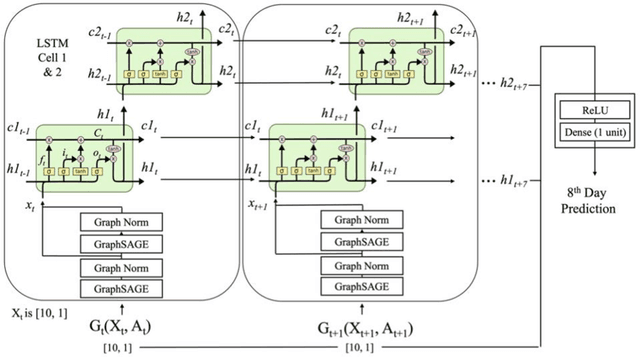
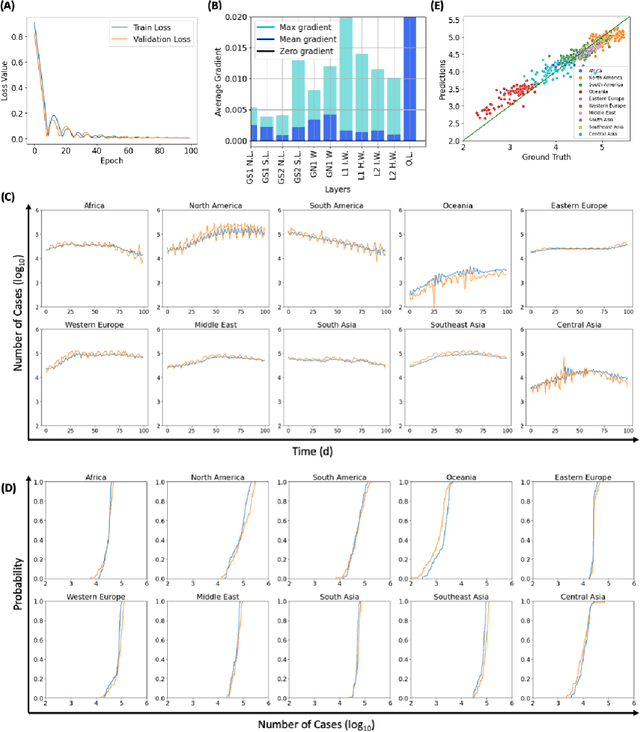
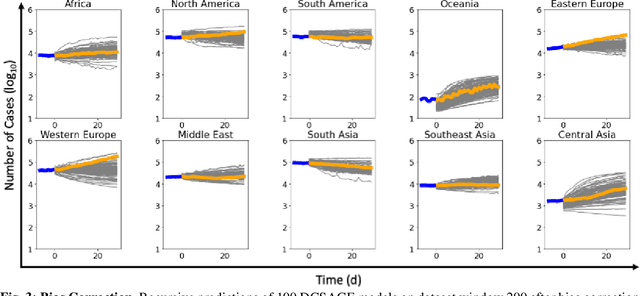
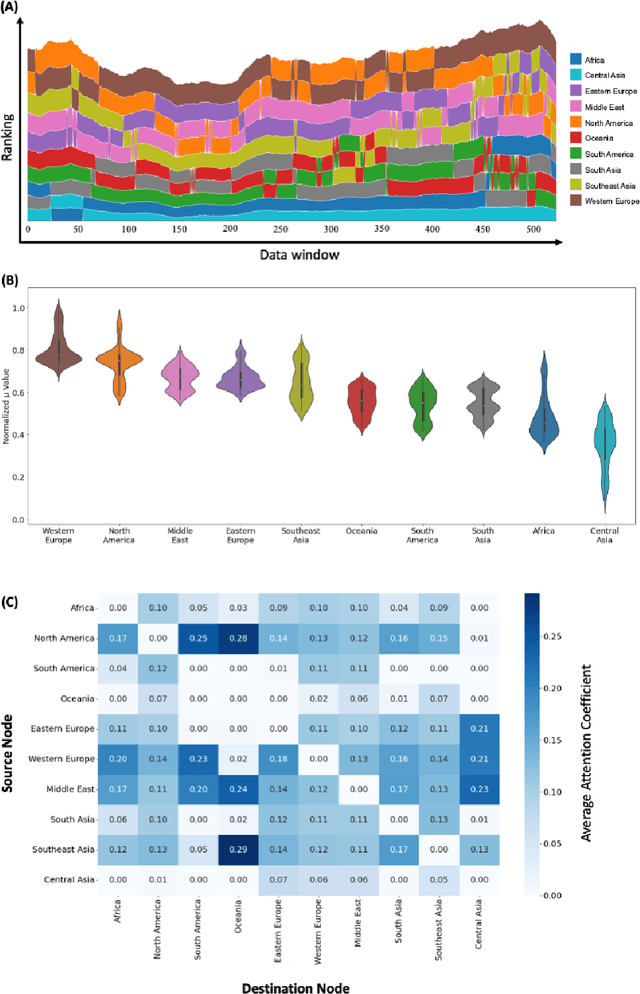
Abstract:The COVID-19 pandemic has affected countries across the world, demanding drastic public health policies to mitigate the spread of infection, leading to economic crisis as a collateral damage. In this work, we investigated the impact of human mobility (described via international commercial flights) on COVID-19 infection dynamics at the global scale. For this, we developed a graph neural network-based framework referred to as Dynamic Connectivity GraphSAGE (DCSAGE), which operates over spatiotemporal graphs and is well-suited for dynamically changing adjacency information. To obtain insights on the relative impact of different geographical locations, due to their associated air traffic, on the evolution of the pandemic, we conducted local sensitivity analysis on our model through node perturbation experiments. From our analyses, we identified Western Europe, North America, and Middle East as the leading geographical locations fueling the pandemic, attributed to the enormity of air traffic originating or transiting through these regions. We used these observations to identify tangible air traffic reduction strategies that can have a high impact on controlling the pandemic, with minimal interference to human mobility. Our work provides a robust deep learning-based tool to study global pandemics and is of key relevance to policy makers to take informed decisions regarding air traffic restrictions during future outbreaks.
PICASO: Permutation-Invariant Cascaded Attentional Set Operator
Jul 17, 2021



Abstract:Set-input deep networks have recently drawn much interest in computer vision and machine learning. This is in part due to the increasing number of important tasks such as meta-learning, clustering, and anomaly detection that are defined on set inputs. These networks must take an arbitrary number of input samples and produce the output invariant to the input set permutation. Several algorithms have been recently developed to address this urgent need. Our paper analyzes these algorithms using both synthetic and real-world datasets, and shows that they are not effective in dealing with common data variations such as image translation or viewpoint change. To address this limitation, we propose a permutation-invariant cascaded attentional set operator (PICASO). The gist of PICASO is a cascade of multihead attention blocks with dynamic templates. The proposed operator is a stand-alone module that can be adapted and extended to serve different machine learning tasks. We demonstrate the utilities of PICASO in four diverse scenarios: (i) clustering, (ii) image classification under novel viewpoints, (iii) image anomaly detection, and (iv) state prediction. PICASO increases the SmallNORB image classification accuracy with novel viewpoints by about 10% points. For set anomaly detection on CelebA dataset, our model improves the areas under ROC and PR curves dataset by about 22% and 10%, respectively. For the state prediction on CLEVR dataset, it improves the AP by about 40%.
First arrival picking using U-net with Lovasz loss and nearest point picking method
Apr 06, 2021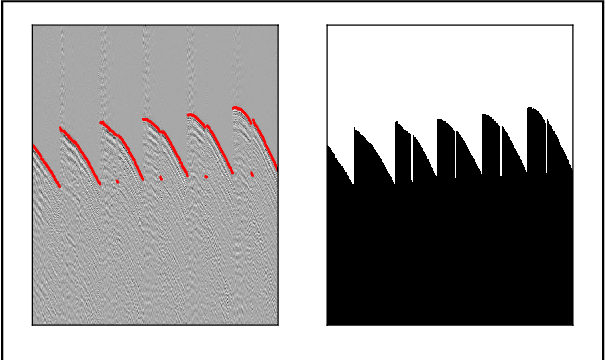
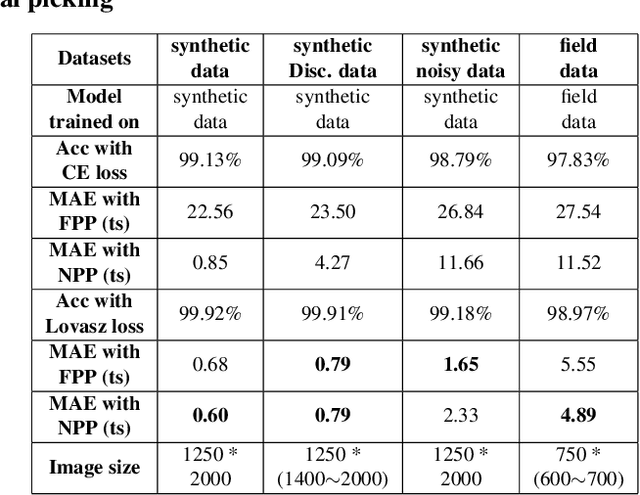
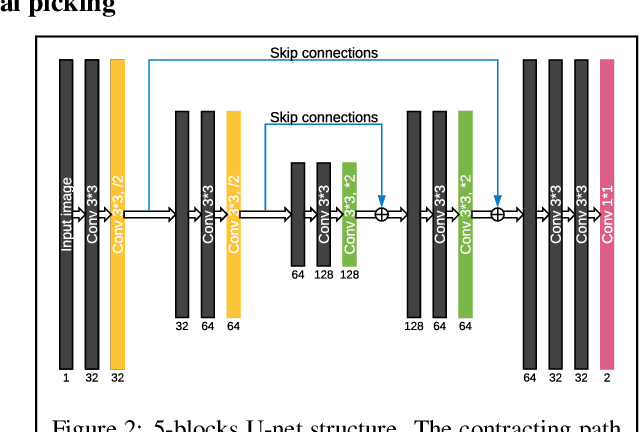
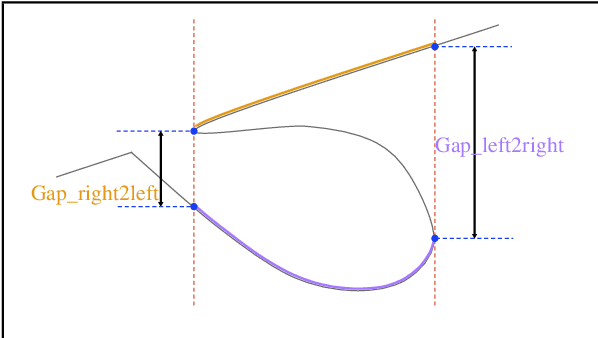
Abstract:We proposed a robust segmentation and picking workflow to solve the first arrival picking problem for seismic signal processing. Unlike traditional classification algorithm, image segmentation method can utilize the location information by outputting a prediction map which has the same size of the input image. A parameter-free nearest point picking algorithm is proposed to further improve the accuracy of the first arrival picking. The algorithm is test on synthetic clean data, synthetic noisy data, synthetic picking-disconnected data and field data. It performs well on all of them and the picking deviation reaches as low as 4.8ms per receiver. The first arrival picking problem is formulated as the contour detection problem. Similar to \cite{wu2019semi}, we use U-net to perform the segmentation as it is proven to be state-of-the-art in many image segmentation tasks. Particularly, a Lovasz loss instead of the traditional cross-entropy loss is used to train the network for a better segmentation performance. Lovasz loss is a surrogate loss for Jaccard index or the so-called intersection-over-union (IoU) score, which is often one of the most used metrics for segmentation tasks. In the picking part, we use a novel nearest point picking (NPP) method to take the advantage of the coherence of the first arrival picking among adjacent receivers. Our model is tested and validated on both synthetic and field data with harmonic noises. The main contributions of this paper are as follows: 1. Used Lovasz loss to directly optimize the IoU for segmentation task. Improvement over the cross-entropy loss with regard to the segmentation accuracy is verified by the test result. 2. Proposed a nearest point picking post processing method to overcome any defects left by the segmentation output. 3. Conducted noise analysis and verified the model with both noisy synthetic and field datasets.
Few Is Enough: Task-Augmented Active Meta-Learning for Brain Cell Classification
Jul 09, 2020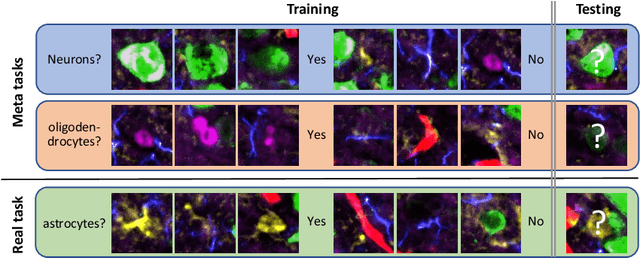



Abstract:Deep Neural Networks (or DNNs) must constantly cope with distribution changes in the input data when the task of interest or the data collection protocol changes. Retraining a network from scratch to combat this issue poses a significant cost. Meta-learning aims to deliver an adaptive model that is sensitive to these underlying distribution changes, but requires many tasks during the meta-training process. In this paper, we propose a tAsk-auGmented actIve meta-LEarning (AGILE) method to efficiently adapt DNNs to new tasks by using a small number of training examples. AGILE combines a meta-learning algorithm with a novel task augmentation technique which we use to generate an initial adaptive model. It then uses Bayesian dropout uncertainty estimates to actively select the most difficult samples when updating the model to a new task. This allows AGILE to learn with fewer tasks and a few informative samples, achieving high performance with a limited dataset. We perform our experiments using the brain cell classification task and compare the results to a plain meta-learning model trained from scratch. We show that the proposed task-augmented meta-learning framework can learn to classify new cell types after a single gradient step with a limited number of training samples. We show that active learning with Bayesian uncertainty can further improve the performance when the number of training samples is extremely small. Using only 1% of the training data and a single update step, we achieved 90% accuracy on the new cell type classification task, a 50% points improvement over a state-of-the-art meta-learning algorithm.
 Add to Chrome
Add to Chrome Add to Firefox
Add to Firefox Add to Edge
Add to Edge